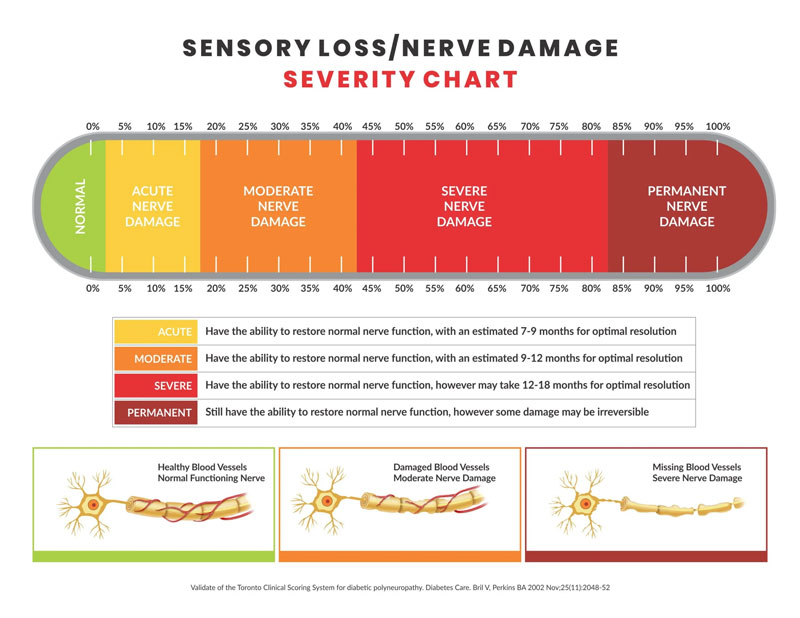Small Fiber Neuropathy

Background
Small Fiber Neuropathy, also called Small Fiber Sensory Neuropathy (SFSN) is a condition whereby only the small superficial (cutaneous) sensory nerves are affected. There is confusion among medical professionals and patients alike as to the various designations and diagnoses that are given for various Neuropathies. Neuropathy affecting the Autonomic Nerves, for example, is yet another type of Small Fiber Neuropathy. We prefer the extra clarity given by the terms Small Fiber Sensory Neuropathy (SFSN), Autonomic Neuropathy, Polyneuropathy, etc and utilize these terms in our Carmel, Indiana Neuropathy Clinic.
This condition is commonly thought of as being caused by Diabetes. However, according to Johns Hopkins, “in a significant percentage of patients, no underlying etiology is found and the patients have idiopathic SFSN.” We also see a large percentage of patients with Neuropathy in the Carmel and Indianapolis area with auto-immune causes. Additionally, Johns Hopkins sites studies in which patients without diabetes had Neuropathies that progressed just as aggressively as those with uncontrolled diabetes.
Large Fiber Neuropathy
We contrast small fiber neuropathy with conditions that affect large fiber nerves. These would include motor nerves and large-diameter sensory nerves including those for vibration and, ultimately, balance.
How Are Each Diagnosed?
Large Fiber Neuropathy is easily diagnosed by needle EMG and NCV testing. However, those diagnostic tests cannot diagnose any Small Fiber Neuropathies. Skin biopsy is the preferred method of diagnosis for SFSN. A small skin biopsy is sent to a lab where the number of nerve fibers is counted. Peripheral neuropathy will lower the number of nerve fibers in the sample as the nerve damage causes the fibers to die off. Additional testing can be done for Autonomic neuropathy and auto-immune neuropathy.
Now, there are limitations with the skin biopsies. Namely, what specific types of sensory nerves are affected? The skin biopsy tests merely count the number of nerve fibers and compare this with normal values. It is important to assess which nerve functions are affected by the neuropathy and to what degree. This can be achieved by utilizing a modified Toronto Clinical Neuropathy Score which includes:
- Cold Touch
- Hot
- Light Touch
- Pin Prick
- Vibration
- Pin Wheel
- Position Sense
Typical Treatment
A typical treatment usually involves a combination of Neurontin/Gabapentin, Lyrica, Anti-depressants, and Opioids. Physical Therapy for balance and strength complaints is sometimes added, but usually not for meaningful lengths due to insurance restrictions.
A Comprehensive Treatment Approach Is Needed
The key is having a comprehensive, thorough treatment that addresses the underlying causes seen with most Polyneuropathy patients./p>
#1
Correct any underlying autoimmune component. If this is not done, long-term results can never be expected because the body is continually fighting itself.
#2
Getting optimal levels of the appropriate nutrients and non-nutrient compounds in the target areas thereby prepping the body for healing. If the body does not have the right building blocks in the right levels, it will not heal.
#3
Improving the blood flow AND blood supply with angiogenesis (new blood vessel growth). Some devices improve blood flow, but only in established vessels. New blood vessel growth is needed in cases where nerve damage is beyond a certain threshold. See the bottom portion of the image below.

#4
Re-educate and re-stimulate the nerves in the damaged area. When done properly, this can re-polarize and re-connect the damaged nerve cells. We use special FDA-cleared devices in our Carmel, IN Neuropathy clinic to achieve this.
Note:
This is not an exhaustive list. Some require additional components in those with Spinal stenosis or other back and neck components, heart disease, alcoholism, thyroid issues, etc.
